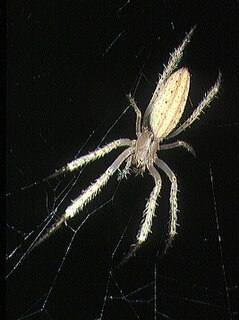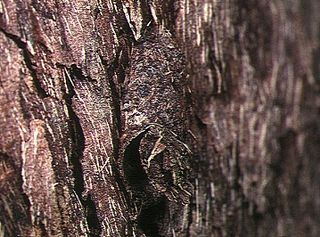
Nursery web spiders (Pisauridae) is a family of araneomorph spiders first described by Eugène Simon in 1890. They resemble wolf spiders (Lycosidae) except for several key differences. Wolf spiders have two very prominent eyes in addition to the other six, while a nursery web spider's eyes are all about the same size. Additionally, female nursery web spiders carry their egg sacs with their jaws and pedipalps instead of attaching them to their spinnerets as wolf spiders do. When the eggs are about to hatch, a female spider builds a nursery "tent", places her egg sac inside, and stands guard outside, hence the family's common name. Like the wolf spiders, however, the nursery web spiders are roaming hunters that don't use webs for catching prey.

Lynx spider (Oxyopidae) is a family of araneomorph spiders first described by Tamerlan Thorell in 1870. Most species make little use of webs, instead spending their lives as hunting spiders on plants. Many species frequent flowers in particular, ambushing pollinators, much as crab spiders do. They tend to tolerate members of their own species more than most spiders do, and at least one species has been identified as exhibiting social behaviour.

Dictynidae is a family of cribellate, hackled band-producing spiders first described by Octavius Pickard-Cambridge in 1871. Most build irregular webs on or near the ground, creating a tangle of silken fibers among several branches or stems of one plant.

Chrysilla is a genus of jumping spiders that was first described by Tamerlan Thorell in 1887. Several species formerly placed here were transferred to Phintella, and vice versa. Females are 3 to 4 millimetres long, and males are 4 to 9 millimetres long. The genus is Persian, derived from the Greek Χρύσιλλα.

Epocilla is a genus of jumping spiders that was first described by Tamerlan Thorell in 1887. The name comes from Ἐπόκιλλος (Epocillus), a soldier of Alexander the Great.

Telamonia is a genus of jumping spiders that was first described by Tamerlan Thorell in 1887. They are colorful spiders, with patterns that vary considerably between sexes and species. Two longitudinal stripes along the abdomen are common, and the carapace is often colored. They have a slender opisthosoma and long legs.

Ordgarius is a genus of orb-weaver spiders first described by Eugen von Keyserling in 1886. Adult females of the genus are bolas spiders, capturing their prey with one or more sticky drops at the end of a single line of silk rather than in a web. Males and juvenile females capture their prey directly with their legs.
Pacullidae is a family of araneomorph spiders first described by Eugène Simon in 1894. It was merged into Tetrablemmidae in 1958, then raised back to family status after a large phylogenetic study in 2017.

Cyrtarachne is a genus of orb-weaver spiders first described by Tamerlan Thorell in 1868.

Lipocrea is a genus of orb-weaver spiders first described by Tamerlan Thorell in 1878.
Oedignatha is a genus of Asian spiders first described by Tamerlan Thorell in 1881 as a genus of corinnid sac spiders, and moved to Liocranidae in 2014.

Poltys is a genus of orb-weaver spiders first described by C. L. Koch in 1843. Many species are cryptic and are known to masquerade as leaves and twigs during the day, and build an orb web at night to capture prey. The shape of the abdomen which often gives the impression of a rough and broken branch can vary among individuals within a species. The web is eaten up before dawn and reconstructed after dusk.
Alistra is a genus of dwarf sheet spiders that was first described by Tamerlan Thorell in 1894.

Conothele is a genus of mygalomorph spiders in the family Halonoproctidae, first described by Tamerlan Thorell in 1878. Originally placed with the Ctenizidae, it was moved to the Halonoproctidae in 2018.
Perania is a genus of Asian araneomorph spiders in the family Pacullidae that was first described by Tamerlan Thorell in 1890. It is considered a senior synonym of Mirania.
Timonoe is a monotypic genus of Burmese long-jawed orb-weavers containing the single species, Timonoe argenteozonata. It was first described by Tamerlan Thorell from a female found in 1898, and it has only been found in Myanmar.
Deione is a genus of Asian orb-weaver spiders first described by Tamerlan Thorell in 1898.
Talthybia is a genus of Asian orb-weaver spiders containing the single species, Talthybia depressa. It was first described by Tamerlan Thorell in 1898, and has only been found in China and Myanmar.

Hygropoda is a genus of nursery web spiders that was first described by Tamerlan Thorell in 1894.

Althepus is a genus of spiders in the family Psilodercidae. It was first described in 1898 by Tamerlan Thorell. As of 2019, it contains 60 species, all from Asia.












